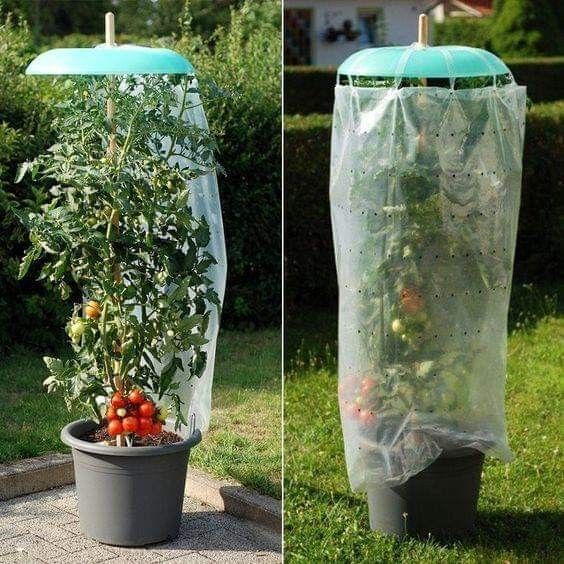Tomatoes are one of the most popular and rewarding vegetables to grow, whether you have a spacious backyard or a small balcony. Growing your own tomatoes can be a fun and satisfying experience, and with a few simple tips, you can grow them successfully at home. Here are 20 easy ways to grow your tomatoes:
1. Choose the Right Tomato Variety
Start by selecting a tomato variety that suits your growing environment. There are two main types:
Indeterminate tomatoes: Grow continuously, producing fruit throughout the season (e.g., Roma, Beefsteak).
Determinate tomatoes: Grow to a fixed height and produce all their fruit at once (e.g., Patio Princess, Bush Early Girl).
2. Start with Healthy Seeds or Seedlings
For best results, purchase high-quality seeds or seedlings from a reliable nursery. You can also start tomatoes indoors if you’re in a colder climate, giving them a head start before transplanting them outside.
3. Use Quality Soil
Tomatoes need well-draining, fertile soil rich in organic matter. A loamy soil is ideal. Add compost or well-rotted manure to enrich the soil before planting.
4. Plant in Full Sun
Tomatoes need at least 6-8 hours of direct sunlight per day to thrive. Choose a sunny spot in your garden, or if growing in containers, place them where they’ll get ample sunlight.
5. Use Containers for Small Spaces
If you don’t have garden space, use containers or grow bags. Tomatoes can grow well in containers if they are large enough and have good drainage. Choose containers that are at least 5 gallons in size.
6. Plant Deep
When transplanting tomatoes, plant them deeper than they were in their original container. Burying the stem will encourage the plant to develop additional roots, which will make it stronger and more productive.
7. Space Plants Properly
Give each tomato plant enough room to grow. Space determinate varieties 18-24 inches apart and indeterminate varieties 24-36 inches apart to allow for proper air circulation and sunlight penetration.
8. Use Mulch
Mulching around your tomato plants helps retain moisture, regulate soil temperature, and prevent weeds. Use organic mulches such as straw, grass clippings, or shredded leaves.
9. Water Consistently
Tomatoes need consistent watering to prevent stress. Water at the base of the plant, not on the leaves, to avoid fungal issues. Aim for 1-2 inches of water per week depending on weather conditions.
10. Water Early in the Day
Watering in the morning gives plants a chance to dry off before the evening, reducing the risk of fungal infections. Watering early also prevents evaporation losses.
11. Fertilize Regularly
Fertilize tomatoes with a balanced fertilizer that contains nitrogen, phosphorus, and potassium. Avoid too much nitrogen, as it can lead to leafy growth at the expense of fruit. Fertilize every 4-6 weeks during the growing season.
12. Support Your Tomato Plants
Use stakes, cages, or trellises to support your tomato plants. This keeps the plants upright and allows air to circulate, reducing the risk of diseases and pests. It also prevents the fruit from touching the ground.
13. Prune for Better Growth
Pruning helps the plant focus its energy on producing fruit rather than excessive leaf growth. Trim back suckers (small shoots between the main stem and branches) and remove any dead or diseased leaves.
14. Provide Proper Air Circulation
Good air circulation is crucial for healthy tomato plants. Make sure to space plants properly and avoid overcrowding. A gentle breeze or fan can help prevent fungal diseases.
15. Avoid Overwatering
While tomatoes need plenty of water, overwatering can lead to root rot and other problems. Ensure that the soil is well-draining, and avoid letting your plants sit in waterlogged soil.
16. Use Organic Pest Control
Keep an eye out for pests such as aphids, tomato hornworms, and whiteflies. Use natural pest control methods like companion planting (e.g., basil or marigolds) or introducing beneficial insects such as ladybugs.
17. Control Temperature Extremes
Tomatoes are sensitive to temperature. Daytime temperatures between 70-85°F and nighttime temperatures between 55-70°F are ideal. If you live in an area with extreme temperatures, consider using shade cloth or row covers to regulate the environment.
18. Harvest at the Right Time
Tomatoes are ready to harvest when they are fully colored (red, yellow, orange, or purple depending on the variety) and slightly soft to the touch. Pick them carefully to avoid damaging the plant.
19. Rotate Your Crops
To prevent soil-borne diseases, avoid planting tomatoes in the same spot year after year. Rotate your crops every season to keep the soil healthy and reduce pest problems.
20. Save Seeds for Next Year
If you’re growing heirloom tomatoes, you can save seeds from your best-performing plants for future seasons. Let the fruit ripen fully, then extract the seeds, clean them, and store them in a cool, dry place for the next planting season.
By following these 20 easy steps, you’ll be well on your way to growing healthy, delicious tomatoes in your garden. Whether you’re a beginner or a seasoned gardener, these tips will help ensure a bountiful tomato harvest. Happy gardening! 🍅🌿
More Articles You Might Like
-
Texas Toast Sloppy Joes: The Crunchy, Cheesy Upgrade You Didn’t Know You Needed
There’s something timeless about sloppy joes. For generations, this saucy, savory, and slightly sweet ground beef sandwich has been a go-to comfort food in American kitchens. It’s quick, filling, and family-friendly—perfect for busy weeknights. But what if we told you there’s a way to take this classic dish up a notch? Enter the Texas Toast…
-
Classic Pig Pickin’ Cake
When it comes to Southern desserts, few sweets shine as brightly as the Classic Pig Pickin’ Cake. This nostalgic cake, sometimes called a “Mandarin Orange Cake,” has roots deep in Southern tradition. It gets its playful name from its frequent appearance at pig pickin’s—Southern-style barbecue gatherings where communities come together to enjoy slow-cooked pork, sides,…
-
Lemon Garlic Butter Chicken with Creamy Parmesan Pasta
There’s something irresistible about the combination of tender, golden-browned chicken paired with a creamy pasta coated in Parmesan cheese. Add the brightness of lemon, the depth of garlic, and the richness of butter, and you have a recipe that feels indulgent yet approachable enough for a weeknight dinner. Lemon Garlic Butter Chicken with Creamy Parmesan…



